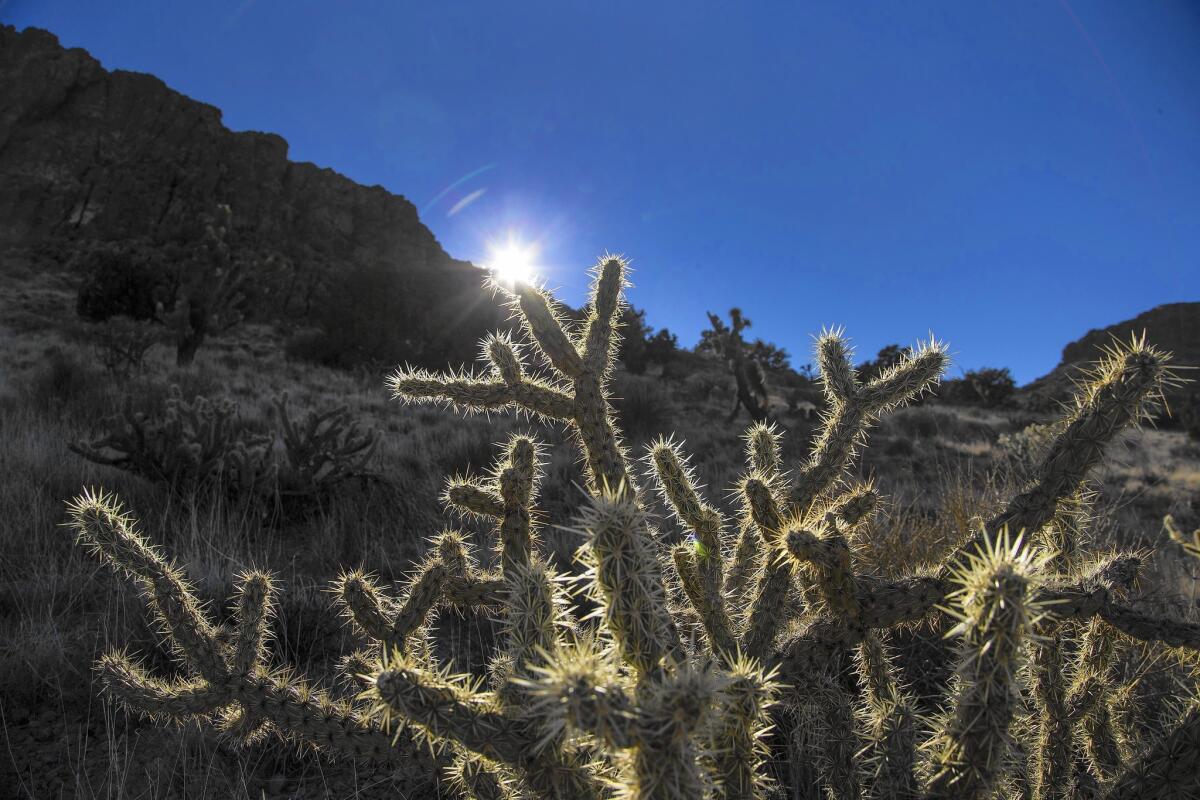Review: The Antelope Valley is home to mini-malls, tract houses and youth who want out in ‘Desert Boys’

- Share via
The young and the rich flock to Coachella and Burning Man and Joshua Tree, because the desert is very much in fashion. Instagram is a constant stream of desert photographs: the boulders, the wildflowers, the boutiques, the stylish millennials posing outside the perfectly aged desert cabins rented for the weekend off Airbnb.
The high desert north of Los Angeles has seen no such surge in visitors. This western corner of the Mojave would have made a beautiful and popular national park, with its backdrop of snow-capped San Gabriel Mountains, valleys of orange California poppies, and hilly, dense woodlands of Joshua trees and juniper. There is plenty of wildlife: mountain lions, bighorn sheep, bobcats, tortoises and even vast herds of antelope until 1890, the year Yosemite became a national park.
But the Western Mojave was not destined for the kind of euphoric desert mysticism that led humans to set aside Joshua Tree National Park, Mojave National Preserve and the three new California desert national monuments created early this year. The Antelope Valley, as it’s still called 126 years after the last pronghorn antelopes were shot, was too close to Los Angeles, the megalopolis on the other side of the San Gabriels.
Once the railroads and dirt highways were cut across the mountains, agriculture moved in and sucked the valley’s aquifers dry, leaving behind vast tracts of scraped, dead land. The aerospace and defense industries were next to occupy the West Mojave, from the miles of test-flight runways on Rogers Dry Lake to the secret hangars in Palmdale.
There was culture too: The cowboy stars of movies and television kept huge ranches on the Victorville and Apple Valley side of the valley, until they were chopped up and sold off for new suburbs and shopping centers. A pioneering socialist commune rose up at Llano del Rio, lasting until 1917. Aldous Huxley moved to a 40-acre spread in Llano in 1940, spending much of his last two decades there. And David Hockney’s beloved mosaic of desert photographs, “Pearblossom Highway #2,” was assembled from his pictures of a scenic and trash-strewn stretch of Highway 138 nearby. I lived in this desert for a few years, along that same highway, and never ran out of things to do or see: the wedding church from “Kill Bill: Vol. 1,” the Works Progress Administration-built trails descending into Devil’s Punchbowl, the relics of the “Right Stuff” pilots displayed at Edwards Air Force Base.
There’s as much interesting and curious history as you’ll find in better-loved places, but it exists as a separate reality from the blur of cracked stucco tract houses and mini-malls and the same big-box chain stores as anywhere else in California’s suburban and exurban sprawl. The population explosion in the Western Mojave began in the 1970s and became cancerous in the decade leading to the 2008 recession. The people who moved here were economic refugees. They see the same Joshua trees people are fawning over on Instagram, but in the Antelope Valley the starkly weird yuccas are ugly, along with the cholla and the stunted juniper and the Russian thistle that thrives on the otherwise dead agricultural land.
That is the desert of Chris McCormick’s debut, “Desert Boys,” a novelesque collection of linked stories about kids growing up in the Antelope Valley of the early 21st century.
There are no socialist authors writing philosophy booklets in McCormick’s stifling social environment, no famous gay artists, no nature-loving hipsters from Echo Park or Venice arriving every weekend. The boys only occasionally venture into the untamed desert, mostly in their early teenage years when they create a paintball war zone among the Joshua trees and dumped furniture just beyond their housing development. The working-class population of the Western Mojave has a Civil War mascot at the high school, where neo-Nazi skinheads recruit from a student body that is unlikely to drift far away from the nothing realm of their childhood.
McCormick’s narrator is a closeted gay teen with an immigrant mother, but even he gets an invite from the local chapter of the skinheads. He is bright and ambitious, and it feels like a given that he will escape the dead-end life and go to the Bay Area, where he eventually encounters an ambitious young black politician who also fled the Antelope Valley, but not before wearing the Civil War mascot costume with local pride.
McCormick writes of the High Desert losing its remote personality as his protagonist grows up, but that really happened in the decade before his birth, when developers rapidly transformed an immense landscape occasionally interrupted by scattered small developments connected by two-lane country roads into a more arid version of the crowded Inland Empire. Over the 1980s, the population of the Antelope Valley doubled, to a quarter-million people living in what was then a newer (and more affordable) suburbia than what they had left behind in the Los Angeles basin. It has taken a quarter-century for the Antelope Valley to repeat that kind of population growth. Today, nearly half a million people live in this desert sprawl. If it wasn’t in Southern California, the Antelope Valley would count as a large metropolitan area.
To come from a place such as the Western Mojave in the early 21st century is not quite a small-town upbringing. Instead, it’s a geographically isolated yet hyper-connected suburbia like any Sun Belt sprawl, with the same chain stores and chain food and eight-lane boulevards between housing developments and the freeway. Los Angeles, the cultural capital of the world for good or ill, is the heart of this gargantuan metropolitan area.
Some 100,000 High Desert residents commute over the mountain passes every morning and every evening. High-schoolers do beach days and Magic Mountain trips like any Southern California kid. Your basketball team is the Lakers and the newer neighborhoods are nothing more than bedroom communities. You have to get out to one of the few rural towns remaining in the foothills, such as Phelan and Piñon Hills and Valyermo, with their 5-acre parcels and dressage rings, to locate a place-specific community.
Los Angeles is so omnipresent, especially in the local television channels with their local news and sports events that define so much of a place’s identity, that those ambitious and unconventional kids who get away are magnetically attracted to San Francisco and the East Bay rather than the bigger and arguably more important city just an hour’s drive to the south. (Or four hours, depending on traffic and/or snow on the 14 or Cajon Pass.)
And so McCormick’s characters go north and come south again to visit family, see which old friends are still around, who got murdered, who went to jail, who turned out pretty much like you’d expect from knowing them at age 11. McCormick’s narrator also comes home to mourn with a young widow who lost her husband not in the desert here but in the desert far away, in the Wars on Terrorism. Enlisting is one of the few ways out for most of these young men, the only world travel most of this economically barren exurban generation will experience. And then they come home, if they make it back alive, to a place they’ll never love, an exotic and wildly beautiful landscape made dull, mean and ugly by the charmless exurbs built for economic refugees.
Layne is the editor of Desert Oracle, a quarterly print journal about the American Desert, and the author of the novel “Dignity,” also set in the Western Mojave.
::
“Desert Boys”
By Chris McCormick
Picador: 240 pp., $25
ALSO
How did ‘Space Raptor Butt Invasion’ by Chuck Tingle become a Hugo finalist?
Anna Kendrick’s book, ‘Scrappy Little Nobody,’ gets November release date
Father’s memoir spurs Scientology leader David Miscavige to threaten lawsuit
More to Read
Sign up for our Book Club newsletter
Get the latest news, events and more from the Los Angeles Times Book Club, and help us get L.A. reading and talking.
You may occasionally receive promotional content from the Los Angeles Times.





